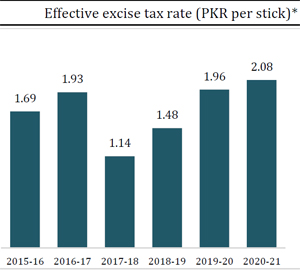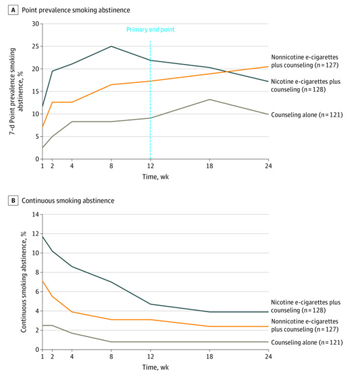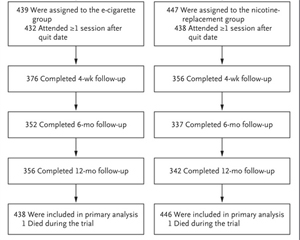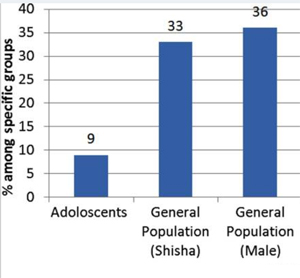Asian American adolescent e-cigarette use and associated protective factors: Heterogeneity in a statewide sample
Objectives: This study characterized variation in e-cigarette use patterns and related protective factors by ethnicity among Asian American adolescents.
Disparities in trajectories of cigarette and E-cigarette use across sexual orientation groups of young adult men and women in the US
Limited research has examined differences in cigarette/e-cigarette use trajectories among specific subgroups of sexual minority (SM) young adult (SMYA) men and women.
Testing the consequences of alcohol, cannabis, and nicotine use on hippocampal volume: a quasi-experimental cotwin control analysis of young adult twins
Alcohol, cannabis, and nicotine use are highly comorbid and alarmingly prevalent in young adults. The hippocampus may be particularly sensitive to substance exposure. This remains largely untested in humans and familial risk may confound exposure effects. We extend prior work on alcohol and hippocampal volume in women by testing common and unique substance use effects and the potential moderating role of sex on hippocampal volume during emerging adulthood. A quasi-experimental cotwin control (CTC) design was used to separate familial risk from exposure consequences.
Associations between polygenic risk of substance use and use disorder and alcohol, cannabis, and nicotine use in adolescence and young adulthood in a longitudinal twin study
Recent well-powered genome-wide association studies have enhanced prediction of substance use outcomes via polygenic scores (PGSs). Here, we test (1) whether these scores contribute to prediction over-and-above family history, (2) the extent to which PGS prediction reflects inherited genetic variation v. demography (population stratification and assortative mating) and indirect genetic effects of parents (genetic nurture), and (3) whether PGS prediction is mediated by behavioral disinhibition prior to substance use onset.
Prevalence of depressive symptoms and cannabis use among adult cigarette smokers in Canada: cross-sectional findings from the 2020 International Tobacco Control Policy Evaluation Project Canada Smoking and Vaping Survey
Tobacco smoking and cannabis use are independently associated with depression, and evidence suggests that people who use both tobacco and cannabis (co-consumers) are more likely to report mental health problems, greater nicotine dependence and alcohol misuse than those who use either product exclusively.
Associations between smoking and vaping prevalence, product use characteristics, and mental health diagnoses in Great Britain: a population survey
Rates of diseases and death from tobacco smoking are substantially higher among those with a mental health condition (MHC). Vaping can help some people quit smoking, but little is known about vaping among people with MHCs or psychological distress. We assessed the prevalence and characteristics (heaviness, product type) of smoking and/or vaping among those with and without a history of single or multiple MHC diagnoses and with no, moderate or serious psychological distress.
Correlates of COVID-19 vaccine uptake among U.S. College students
Hesitance toward COVID-19 vaccination has greatly decreased over the course of the pandemic in the U.S. However, some populations have lower vaccination rates than the general population. This study was conducted to identify correlates of being fully vaccinated (i.e., having received all doses required to be fully vaccinated) among college students using students' responses to the 2022 Spring American College Health Association-National College Health Assessment.
Comparing Smokeless Tobacco Use between Male-to-Female and Female-to-Male Transgender Adults in the United States
Background: The shifted gender social norms and tobacco cessation advice associated with estrogen therapy as a result of thrombosis risk could be responsible for the tobacco use differences between Male-to-Female (MTF) and Female-to-Male (FTM) transgender adults. Research has established this disparity in cigarette smoking, but none has looked at smokeless tobacco.
Misconceptions of Vaping Among Young Adults
Background Vaping is growing in popularity worldwide, especially among young adults. To develop effective tobacco prevention interventions, first, there must be an understanding of the attitudes and perceptions of young adults toward the use of vaping. Highlighting perception discrepancies between races may allow physicians to more effectively counsel their patients regarding the risks of vaping.
Exposure to E-Cigarette Advertising and Its Association With E-Cigarette Use Among Youth and Adolescents in Two Largest Cities in Vietnam 2020
Background: E-cigarette products have become more popular due to the marketing campaigns on various sources but caused adverse health impacts to users, especially adolescents and youths. This paper aims to describe the situation of exposure to e-cigarette advertisements of youth and adolescents living in two cities of Hanoi and Ho Chi Minh in 2020 and identify the associated factors of e-cigarette marketing with e-cigarettes use in these groups.
Changes in perceived harms of tobacco and cannabis and their correlations with use: A panel study of young adults 2014-2020
Purpose: Perceived harm is associated with substance use. Changes in product and policy landscapes may impact perceived harms of tobacco and cannabis. This study aimed to examine changes in young adults' perceived harms of tobacco and cannabis and their associations with use behavior during a period including both before and after legalization of cannabis.
The global impact of tobacco control policies on smokeless tobacco use: a systematic review
Background: Smokeless tobacco, used by more than 300 million people globally, results in substantial morbidity and mortality. For smokeless tobacco control, many countries have adopted policies beyond the WHO Framework Convention on Tobacco Control, which has been instrumental in reducing smoking prevalence. The impact of these policies (within and outside the Framework Convention on Tobacco Control) on smokeless tobacco use remains unclear.
Nicotine Vaping and Co-occurring Substance Use Among Adolescents in the United States from 2017-2019
Background: The use of electronic cigarettes (or "vaping") among adolescents remains a public health concern given exposure to harmful substances, plus potential association with cannabis and alcohol. Understanding vaping as it intersects with combustible cigarette use and other substance use can inform nicotine prevention efforts.
Prevalence of active and passive smoking among asthma and asthma-associated emergency admissions: a nationwide prevalence survey study
Asthma affects 7% of children and 8% of adults in the United States. There is a paucity of studies examining the association between passive smoking and an increased risk of asthma exacerbations that led the authors to examine the association between various modes of smoking and rates of asthma exacerbations.
Associations between e-cigarette use or dual use of e-cigarette and combustible cigarette and metabolic syndrome: Results from the National Health and Nutrition Examination Survey (NHANES)
Purpose: Examine associations between e-cigarette use or dual use of e-cigarette and combustible cigarette and metabolic syndrome (MetS).
CHRNA5 gene variation affects the response of VTA dopaminergic neurons during chronic nicotine exposure and withdrawal
Nicotine is the principal psychoactive component in tobacco that drives addiction through its action on neuronal nicotinic acetylcholine receptors (nAChR).
Variation in adults' use of flavored tobacco products by sales restrictions in California jurisdictions
Background: State and local policies prohibiting the sales of flavored tobacco have been effective in curtailing retail availability and sales of products across the United States. Less is known about the use of flavored tobacco which could vary as a function of type of ordinance, product category, policy implementation, and other factors.
Associations between e-cigarette policies and adolescent use and access to e-cigarettes
Background: Tobacco control policies have been adapted to address rising levels of adolescent e-cigarette use. Despite new restrictions, adolescents are continuing to access e-cigarettes.
Use of tobacco, nicotine and cannabis products among students in Switzerland
Introduction: Most people who smoke cigarettes begin in their teens and teens may also be attracted to new tobacco, nicotine, and cannabis products. We describe use prevalence among upper-secondary school students in Switzerland, including daily use, of tobacco, nicotine, and cannabis products.
Smokers' utilization of quitting methods and vaping during pregnancy: an empirical cluster analysis of 2016-2018 Pregnancy Risk Assessment Monitoring System (PRAMS) data in seven US states
Background: Patterns of utilization of numerous smoking cessation methods among pregnant women amidst the increasing popularity of vaping (use of e-cigarettes) remains unknown.
Polysubstance use and its correlation with psychosocial and health risk behaviours among more than 95,000 Norwegian adolescents during the COVID-19 pandemic (January to May 2021): a latent profile analysis
Background: Polysubstance use represents an adolescent health risk; however, large-scale studies investigating this issue during the COVID-19 pandemic are scarce. We aim to (i) characterise substance use profiles among adolescents and (ii) identify correlates of such substance use profiles.
Associations between depression, stress, and e-cigarette use among OEF/OIF veterans
The COVID-19 pandemic has had profound mental and behavioral health implications for the general U.S. population. However, little is known regarding outcomes for U.S. veterans, who represent a population with high rates of depression, stress, and e-cigarette use. One month prior to the pandemic-related closures (February 2020), 1230 OEF/OIF veterans (ages 18-40) completed an online baseline survey.
Older age is associated with greater misperception of the relative health risk of e-cigarettes and cigarettes among US adults who smoke
Introduction: The prevalence of cigarette smoking among adults aged >=55 has remained stagnant over the past decade. National data modelling suggests no reduction in cigarette smoking prevalence attributable to e-cigarette use in the USA among people aged >=45. Misperceptions about the absolute risks (ie, cigarettes are not harmful) and relative risks (ie, e-cigarettes are more harmful than cigarettes) of tobacco products may contribute to sustained smoking prevalence and hesitancy to switch from cigarettes to e-cigarettes among older adults.
Tobacco Product Use Among Adults - United States, 2021
Commercial cigarette smoking among U.S. adults has declined during the preceding 5 decades (1,2); however, tobacco product use remains the leading cause of preventable disease and death in the United States, and some populations continue to be disproportionately affected by tobacco use (1,2).
Youth E-cigarette Initiation Following the Food and Drug Administration's Missed Deadline
Introduction: The United States Food and Drug Administration (FDA) was ordered to evaluate electronic nicotine delivery systems (ENDS) products by September 9, 2021, but missed the court-ordered deadline. This study provides an estimate of e-cigarette use initiation among youth and young adults following the FDA's missed deadline.




